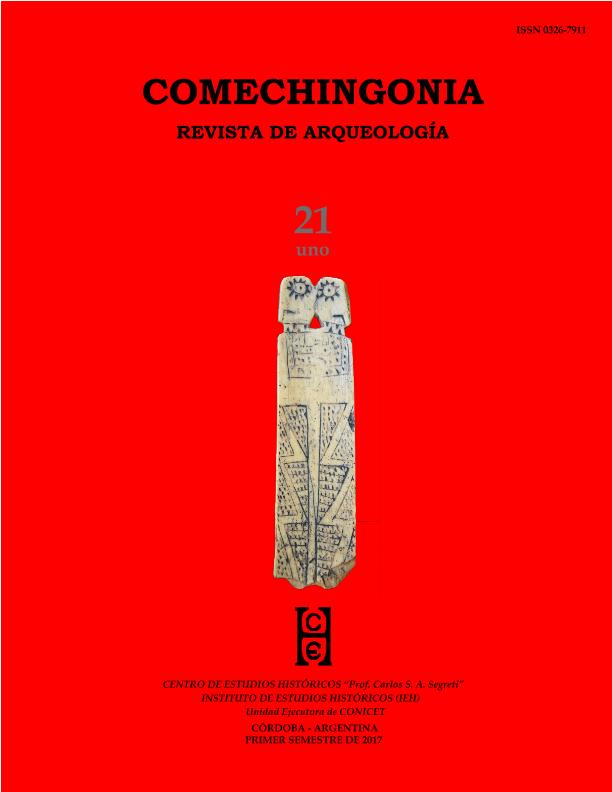Artículo
En este trabajo nos proponemos abordar la espacialidad y materialidad de las comunidadesaldeanas entre ca. 300 a 600 d.C. en el piedemonte oriental de la Sierra de Velasco en el área de lalocalidad de Anillaco (Castro Barros, La Rioja). Para ello seleccionamos un conjunto residencial deescala doméstica que nos permitió acercarnos a los primeros procesos formativos de Anillaco y a susprácticas cotidianas. Presentamos los resultados obtenidos del relevamiento y excavación del sitioUchuquita. Analizamos la espacialidad residencial, los rasgos arquitectónicos y la distribución delos conjuntos cerámicos y faunísticos mediante herramientas estadísticas de interpolación Kriging.Así, reconocimos parámetros distribucionales y áreas de concentración del registro cerámico y óseovisualizando la disposición de los objetos, la organización del espacio y las prácticas cotidianasdesarrolladas en los recintos. Distinguimos el Número Mínimo de Vasijas (NMV) según serie finay ordinaria y realizamos análisis arqueofaunísticos identificando patrones de uso y consumo.Observamos que algunos rasgos culturales se prolongaron espacial y temporalmente en otrascuencas de la Sierra de Velasco, dando cuenta de una continuidad en las formas de hacer. In this paper, we propose a spatial and material approach to the study of the village community that lived between c. 300 and 600 AD in the eastern piedemont of Anillaco’s town (Castro Barros, La Rioja). For this we selected a residential complex of household scale that allows us to determine the first formative processes of Anillaco and the daily practices. We presented the results obtained of surveys and excavations in Uchuquita site. We analyzed from a comprehensive and contextual point of view the residential spatiality, the architectural features and the distribution of the ceramic and faunistic sets, using statistical interpolation tools: Kriging. Thus, we recognized distributional parameters and areas of concentration of the ceramic and bone records, visualizing the arrangement of such objects in the housing areas, the organization of the space and the daily practices developed in them. We distinguished the Number Minimum of Vessels (NMV) according to the fine and ordinary series and we perform archaeofaunistics analysis identifying patterns of use and consumption. We observed that some cultural traits extend spatially and temporally in other basins of the Sierra de Velasco, accounting for continuity in the ways of doing things.
Espacialidad y materialidad de un conjunto de unidades domésticas tempranas -CA. 300-600 D.C.- de Anillaco (La Rioja, Argentina)
Título:
Spatiality and materiality of a set of early household -c. 300-600 AD- of Anillaco (La Rioja, Argentina)
Fecha de publicación:
06/2017
Editorial:
Centro de estudios históricos Prof. Carlos S. A. Segreti
Revista:
Comechingonia
ISSN:
0326-7911
e-ISSN:
2250-7728
Idioma:
Español
Tipo de recurso:
Artículo publicado
Clasificación temática:
Resumen
Palabras clave:
Primer Milenio
,
Doméstico
,
Análisis Intrasitio
,
Consumo
Archivos asociados
Licencia
Identificadores
Colecciones
Articulos(CRILAR)
Articulos de CENTRO REGIONAL DE INV. CIENTIFICAS Y TRANSFERENCIA TECNOLOGICA DE ANILLACO
Articulos de CENTRO REGIONAL DE INV. CIENTIFICAS Y TRANSFERENCIA TECNOLOGICA DE ANILLACO
Citación
Sabatini Vargas, Gabriela Inés; Garate, Enrique Rubén; Espacialidad y materialidad de un conjunto de unidades domésticas tempranas -CA. 300-600 D.C.- de Anillaco (La Rioja, Argentina); Centro de estudios históricos Prof. Carlos S. A. Segreti; Comechingonia; 21; 1; 6-2017; 99-122
Compartir




